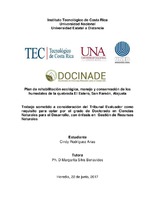Plan de rehabilitación ecológica, manejo y conservación de los humedales de la quebrada El Estero, San Ramón, Alajuela
Resumen
The wetlands of the high watershed of the Estero creek are formed by this stream
and a tributary, a swamp and two reservoirs that are the last remnants of an
ancient lake that existed in the San Ramon area and are considered a
conservation priority due to their representativeness and location that makes them
unique in its kind. However, in recent decades they have suffered a degradation
processes that not only threaten the conservation of ecosystems, but the security
of the human population. Therefore, the objective of this investigation was to
formulate a proposal for a rehabilitation, management and conservation plan for
these wetlands in favor of the rehabilitation of ecosystem services such as
biodiversity conservation, flood mitigation, recreation, environmental education and
scientific research. To begin with, an assessment of the current state of the
wetlands was carried out, including the study of the physico-chemical and
microbiological water quality, conservation status of birds and aquatic plants
communities as bioindicators and the identification of ecosystem services provided
by the wetlands and the threats and impacts of human activities on them. Based on
this assessment, an ecological rehabilitation plan was proposed. It was determined
that these wetlands are being degraded due to rapid urbanization in its upper
watershed, which has caused water pollution mainly by domestic sources, spread
of invasive species, loss of habitat for aquatic species, stuffing in some areas of
the swamp, invasion of protection zones, eutrophication and silting of reservoirs
and decrease in their ability to mitigate floodings in the city of San Ramon.
Therefore, due to the state of degradation and the lack of a reference ecosystem or
ecological information prior to degradation, an ecological rehabilitation plan was
proposed, aimed at solving the problems identified and to the recovery of
ecosystem services. The plan consists of six programs based on the following
elements to intervene: hydroperiod and hydrological regime, water quality, soil and
sediments, invasive exotic species and domestic predators and native flora and
fauna. In addition, a program that allows the participation of civil society in the
different stages of the project was included. Finally, strategies for monitoring and
viii
management of wetlands once they are rehabilitated are also included. As a result
of this investigation and because of the social and environmental importance of
these wetlands, the Western Headquarters of the University of Costa Rica created
the research program for the recovery and sustainability of the upper watershed of
the Estero creek, composed of 11 research and social action projects in different
disciplines. This program has coordinated with other institutions, civic groups and
local companies, which have allowed that some of the actions included in this
proposal are already underway.
Descripción
Tesis (Doctorado en Ciencias Naturales para el Desarrollo con énfasis en Gestión de Recursos Naturales) Instituto Tecnológico de Costa Rica. Universidad Nacional de Costa Rica. Universidad Estatal a Distancia, Doctorado en Ciencias Naturales para el Desarrollo, 2017.


